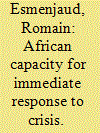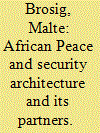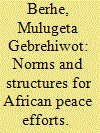| Srl | Item |
| 1 |
ID:
131096


|
|
|
|
|
| Publication |
2014.
|
| Summary/Abstract |
The creation of an African Capacity for Immediate Response to Crisis (ACIRC) is a sign of Africa's willingness to take its destiny into its own hands. Presented as a reaction to the slowness of the development of the African Standby Force (ASF), it is also a response to some of the ASF's conceptual weaknesses. This decision reflects a wish to establish an instrument better equipped to deal with the challenges Africa is facing. Departing from the (sub)regional logic of the ASF results from a desire to take into account the transnational nature of threats, while its enlarged mandate is meant to offer Africa the capacity to intervene in all kinds of conflicts, including by undertaking peace enforcement activities. But the obstacles on the road towards the actual creation and mobilisation of this capacity should not be underestimated. These include material difficulties, but also political tensions, between 'small' and 'big' states as well as between the African Union and subregional organisations. The risk then is high that the ACIRC, whose announcement came as a reaction to France's intervention in Mali, ends up joining the ranks of the many 'anti-imperialist' phantoms haunting the history of the Organization of African Unity/African Union (OAU/AU). Confronted by events considered 'neocolonial' initiatives, African actors have indeed traditionally reacted by launching grand projects that never got off the ground. However, by actually establishing this new instrument, they may also demonstrate that times have definitively changed.
|
|
|
|
|
|
|
|
|
|
|
|
|
|
|
|
| 2 |
ID:
134341


|
|
|
|
|
| Summary/Abstract |
This article presents survey data on the African Peace and Security Architecture (APSA). It focuses explicitly on two aspects: the internal constitution and achievements of the APSA; and coordination and cooperation with external actors, such as Regional Economic Communities, the United Nations and the European Union. The survey, conducted between October 2011 and December 2012, targeted 198 security experts in international organisations, think tanks, academia and non-governmental organisations. It reveals the APSA's current stage of development, achievements and challenges.
|
|
|
|
|
|
|
|
|
|
|
|
|
|
|
|
| 3 |
ID:
153696


|
|
|
|
|
| Summary/Abstract |
The African Peace and Security Architecture (APSA) is a set of norms and structures developed and designed to enable Africa with its peace and security affairs. It is an important instrument that enabled Africa gain significant success in its efforts to promote stability in Africa. The APSA was designed in the early 2000s and Africa needs to fully implement its norms and fully utilize its instruments. There is also a need to address gaps and redundancies so that it fits to the current context of new internal and global challenges.
|
|
|
|
|
|
|
|
|
|
|
|
|
|
|
|